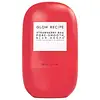What's inside
What's inside
 Key Ingredients
Key Ingredients

 Benefits
Benefits

 Concerns
Concerns

 Ingredients Side-by-side
Ingredients Side-by-side

Water
Skin ConditioningPropanediol
SolventPentylene Glycol
Skin ConditioningGlycerin
HumectantPhenethyl Alcohol
MaskingHydrolyzed Rice Protein
Skin ConditioningPolyglyceryl-6 Caprylate
EmulsifyingPolyglyceryl-3 Cocoate
EmulsifyingPolyglyceryl-4 Caprate
EmulsifyingPolyglyceryl-6 Ricinoleate
EmulsifyingSodium Gluconate
Skin ConditioningErythritol
HumectantHydrolyzed Pea Protein
EmollientCaprylic/Capric Triglyceride
MaskingMaltodextrin
AbsorbentAcacia Seyal Gum Extract
HumectantLactobacillus Ferment
Skin ConditioningArtemisia Capillaris Flower Extract
Skin ConditioningHibiscus Sabdariffa Flower Extract
Skin ConditioningGlycine
BufferingProline
Skin ConditioningHydrolyzed Sodium Hyaluronate
Skin ConditioningPalmitoyl Tripeptide-37
Skin ConditioningPotassium Sorbate
PreservativeCitric Acid
BufferingBenzyl Alcohol
PerfumingSodium Benzoate
MaskingWater, Propanediol, Pentylene Glycol, Glycerin, Phenethyl Alcohol, Hydrolyzed Rice Protein, Polyglyceryl-6 Caprylate, Polyglyceryl-3 Cocoate, Polyglyceryl-4 Caprate, Polyglyceryl-6 Ricinoleate, Sodium Gluconate, Erythritol, Hydrolyzed Pea Protein, Caprylic/Capric Triglyceride, Maltodextrin, Acacia Seyal Gum Extract, Lactobacillus Ferment, Artemisia Capillaris Flower Extract, Hibiscus Sabdariffa Flower Extract, Glycine, Proline, Hydrolyzed Sodium Hyaluronate, Palmitoyl Tripeptide-37, Potassium Sorbate, Citric Acid, Benzyl Alcohol, Sodium Benzoate
Water
Skin ConditioningTapioca Starch
Isopentyldiol
HumectantNylon-12
C9-12 Alkane
SolventDistarch Phosphate
AbsorbentAmmonium Acryloyldimethyltaurate/Vp Copolymer
Saccharide Isomerate
HumectantFragaria Vesca Leaf Extract
AstringentSalicylic Acid
MaskingSalix Alba Bark Extract
AstringentFragaria Vesca Fruit Extract
AstringentLeuconostoc/Radish Root Ferment Filtrate
AntimicrobialSodium Hyaluronate
HumectantBisabolol
MaskingCoco-Caprylate/Caprate
EmollientTriheptanoin
Skin ConditioningButylene Glycol
HumectantPentylene Glycol
Skin ConditioningPropanediol
SolventCaprylyl Glycol
EmollientPolyglyceryl-10 Dioleate
EmulsifyingDilinoleic Acid/Butanediol Copolymer
Polyglyceryl-10 Dipalmitate
EmollientEthylhexylglycerin
Skin ConditioningSodium Hydroxide
Buffering1,2-Hexanediol
Skin ConditioningPhenoxyethanol
PreservativeCastor Oil/Ipdi Copolymer
Citric Acid
BufferingParfum
MaskingWater, Tapioca Starch, Isopentyldiol, Nylon-12, C9-12 Alkane, Distarch Phosphate, Ammonium Acryloyldimethyltaurate/Vp Copolymer, Saccharide Isomerate, Fragaria Vesca Leaf Extract, Salicylic Acid, Salix Alba Bark Extract, Fragaria Vesca Fruit Extract, Leuconostoc/Radish Root Ferment Filtrate, Sodium Hyaluronate, Bisabolol, Coco-Caprylate/Caprate, Triheptanoin, Butylene Glycol, Pentylene Glycol, Propanediol, Caprylyl Glycol, Polyglyceryl-10 Dioleate, Dilinoleic Acid/Butanediol Copolymer, Polyglyceryl-10 Dipalmitate, Ethylhexylglycerin, Sodium Hydroxide, 1,2-Hexanediol, Phenoxyethanol, Castor Oil/Ipdi Copolymer, Citric Acid, Parfum
 Reviews
Reviews

Ingredients Explained
These ingredients are found in both products.
Ingredients higher up in an ingredient list are typically present in a larger amount.
Citric Acid is an alpha hydroxy acid (AHA) naturally found in citrus fruits like oranges, lemons, and limes.
Like other AHAs, citric acid can exfoliate skin by breaking down the bonds that hold dead skin cells together. This helps reveal smoother and brighter skin underneath.
However, this exfoliating effect only happens at high concentrations (20%) which can be hard to find in cosmetic products.
Due to this, citric acid is usually included in small amounts as a pH adjuster. This helps keep products slightly more acidic and compatible with skin's natural pH.
In skincare formulas, citric acid can:
While it can provide some skin benefits, research shows lactic acid and glycolic acid are generally more effective and less irritating exfoliants.
Most citric acid used in skincare today is made by fermenting sugars (usually from molasses). This synthetic version is identical to the natural citrus form but easier to stabilize and use in formulations.
Read more about some other popular AHA's here:
Learn more about Citric AcidPentylene glycol is typically used within a product to thicken it. It also adds a smooth, soft, and moisturizing feel to the product. It is naturally found in plants such as sugar beets.
The hydrophilic trait of Pentylene Glycol makes it a humectant. As a humectant, Pentylene Glycol helps draw moisture from the air to your skin. This can help keep your skin hydrated.
This property also makes Pentylene Glycol a great texture enhancer. It can also help thicken or stabilize a product.
Pentylene Glycol also acts as a mild preservative and helps to keep a product microbe-free.
Some people may experience mild eye and skin irritation from Pentylene Glycol. We always recommend speaking with a professional about using this ingredient in your routine.
Pentylene Glycol has a low molecular weight and is part of the 1,2-glycol family.
Learn more about Pentylene GlycolPropanediol is an all-star ingredient. It softens, hydrates, and smooths the skin.
It’s often used to:
Propanediol is not likely to cause sensitivity and considered safe to use. It is derived from corn or petroleum with a clear color and no scent.
Learn more about PropanediolWater. It's the most common cosmetic ingredient of all. You'll usually see it at the top of ingredient lists, meaning that it makes up the largest part of the product.
So why is it so popular? Water most often acts as a solvent - this means that it helps dissolve other ingredients into the formulation.
You'll also recognize water as that liquid we all need to stay alive. If you see this, drink a glass of water. Stay hydrated!
Learn more about Water